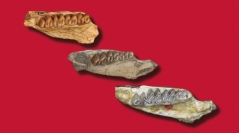

 Geodiversitas
45 (25) - Pages 721-737
Geodiversitas
45 (25) - Pages 721-737Neoreomys Ameghino, 1887 is among the most representative genera of South American Miocene rodents. The systematics of this taxon have been unclear, but currently, the most accepted hypothesis places it within Cavioidea, with ambiguous relationships inside the clade. Neoreomys is abundant and well-represented at high latitudes, with two species from the Early Miocene of Patagonia: N. australis Ameghino, 1887 and N. pinturensis Kramarz, 2006. A third species, N. huilensis Fields, 1957, is recognized from the Mid-Miocene of La Venta, Colombia, in low latitudes of South America. Neoreomys huilensis has been known from a few fragmentary specimens from which Fields (1957) described its holotype. Based on additional collections, Walton (1997) concluded that this species was probably not part of the genus. This study aims to reevaluate the taxonomy, phylogenetic relationships, and paleobiogeography of N.huilensis based on previously and recently collected materials. We present a detailed description of Neoreomys huilensis, corroborating the validity of this species as part of the genera. Our phylogenetic analysis is the first to include the three Neoreomys species, it supports the monophyly of the genus and suggests that it is not directly related to Dasyproctidae, instead corresponds to a plesiomorphic form within Cavioidea sensu stricto. Finally, we propose that the origin of the most recent common ancestor of the Neoreomys species could have occurred in the Andean region or some geographical location in mid-latitudes along the South American Transition Zone. A subsequent northward dispersal along the eastern flank of the Andes Mountain range would have given place to the appearance of N. huilensis in lower latitudes.
Cavioidea, Caviomorpha, Neogene, South America, Honda Group, phylogeny, paleobiogeography